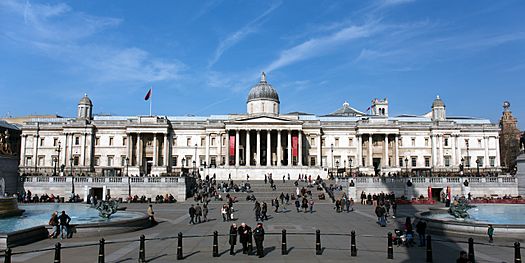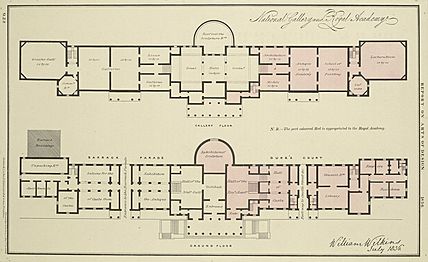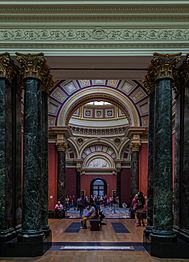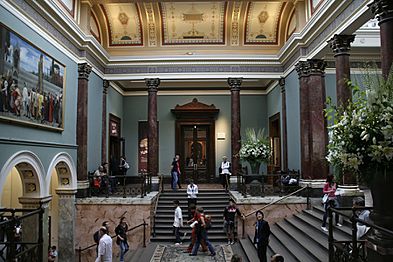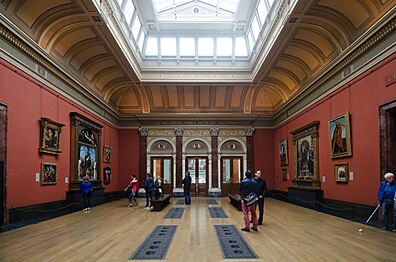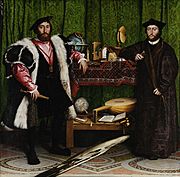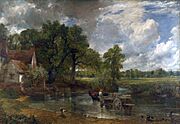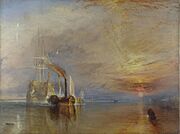National Gallery facts for kids
 |
|
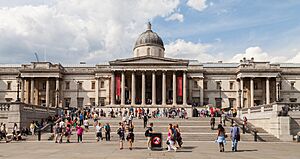
The front of the National Gallery in Trafalgar Square
|
|
| Lua error in Module:Location_map at line 420: attempt to index field 'wikibase' (a nil value). | |
| Established | 1824, current location since 1838 |
|---|---|
| Location | Trafalgar Square, London, England, United Kingdom |
| Type | Art museum |
| Visitors | 3,096,508 (2023) |
| Public transit access | Detailed information below |
The National Gallery is a famous art museum in Trafalgar Square, Central London, England. It opened in 1824 and holds over 2,300 paintings. These artworks date from the mid-13th century all the way to 1900. The current director of the National Gallery is Gabriele Finaldi.
This museum is special because its collection belongs to the British public. This means that visiting the main collection is completely free! Unlike many other European museums, the National Gallery didn't start with a royal art collection. Instead, the British government bought 38 paintings from John Julius Angerstein in 1824.
Since then, the gallery has grown a lot. Many paintings were bought by early directors, like Charles Lock Eastlake. Private donations also added a huge number of artworks. Today, two-thirds of the collection came from generous gifts. The National Gallery might have a smaller collection than some other big European galleries, but it covers a wide range of Western painting. You can see important works from artists like Giotto to Cézanne.
The building you see today is the third home for the National Gallery. It was designed by William Wilkins and opened in 1838. Over the years, the building has been expanded many times. The front part, facing Trafalgar Square, looks much like it did when it first opened.
Contents
The National Gallery's Story
How the National Gallery Began

In the late 1700s, many countries in Europe started opening their royal art collections to the public. Places like the Louvre in Paris and the Uffizi Gallery in Florence became public museums. However, Great Britain didn't do this with its own Royal Collection.
Many people, including artists, wanted Britain to have its own national art gallery. They believed it would help British artists learn and grow. In 1805, a group of wealthy art lovers created the British Institution. They lent paintings for exhibitions and even ran an art school. One of these members, Sir George Beaumont, later played a big part in starting the National Gallery. He promised to donate 16 paintings if the government bought another important collection.
In 1823, a banker named John Julius Angerstein passed away. He had a collection of 38 amazing paintings, including works by Raphael and Hogarth. A politician named George Agar-Ellis suggested that the government buy this collection. With Beaumont's offer, the government finally decided to buy Angerstein's paintings for £57,000. This was a big step towards creating the National Gallery.
First Homes and a New Building
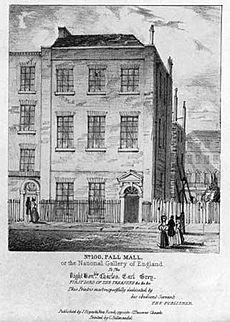
The National Gallery first opened its doors in 1824. It was located in Angerstein's old house at 100 Pall Mall. Sir George Beaumont's paintings joined the collection in 1826. More artworks were added in 1831 from the collection of Reverend William Holwell Carr.
However, the house on Pall Mall quickly became too small and crowded. People thought it was embarrassing compared to huge museums like the Louvre. Even so, many believed the gallery needed to be in a busy part of London. This way, everyone could easily visit it.
In 1832, work began on a brand new building. This new home was in Charing Cross, on the northern side of what would become Trafalgar Square. This spot was chosen because it was between the rich West End and poorer areas. This meant people from all walks of life could come and enjoy the art. The new building opened to the public in 1838.
Growing the Collection
For its first 30 years, the National Gallery mainly bought Italian paintings from the 1400s and 1500s. In 1855, Sir Charles Lock Eastlake became the gallery's first director. He loved art from the early Italian and Northern European Renaissance. He traveled often, especially to Italy, to find paintings for the gallery. He bought many important works, like Paolo Uccello's The Battle of San Romano.
One challenge the gallery faced was its small size. In 1845, Robert Vernon donated a large collection of British paintings. There wasn't enough space, so they were shown in other locations. Later, the famous artist J. M. W. Turner left all his finished paintings to the nation when he died in 1851. These also needed extra space.
The third director, Sir Frederic William Burton, helped build the collection of 18th-century art. He made some amazing purchases. In 1885, the gallery bought two paintings from Blenheim Palace for a huge sum of money. These included Raphael's Ansidei Madonna. In 1897, the Tate Gallery was created for British art. This allowed some British artworks to move there, freeing up space in the National Gallery.
Art in the 20th Century
In the early 1900s, many wealthy families had to sell their paintings. American collectors often bought these artworks. To help keep art in Britain, the National Art-Collections Fund was started. Their first purchase for the National Gallery was Velázquez's Rokeby Venus in 1906.
The gallery also received many generous gifts from private collectors. For example, Ludwig Mond gave 42 Italian Renaissance paintings in 1909.
At first, Impressionist art was very controversial at the gallery. Some people didn't like these modern French paintings. However, over time, these artworks became more accepted. In 1923, Samuel Courtauld created a fund to buy modern paintings. This allowed the gallery to acquire works like Seurat's Bathers at Asnières.
Protecting Art During World War II
Just before World War II started, the gallery's paintings were moved to safe places in Wales. These included castles and university buildings. In 1940, as the war continued, there was even talk of sending the paintings to Canada. But Winston Churchill said no, insisting they stay in Britain. He famously said, "bury them in caves or in cellars, but not a picture shall leave these islands."
So, a slate quarry in Manod, North Wales, became the secret home for the artworks. In this safe place, experts studied the collection and created detailed lists. Moving the paintings also taught them how important it was to keep art at a constant temperature and humidity. This led to the first air-conditioned gallery opening in 1949.
While the paintings were away, the empty National Gallery in Trafalgar Square still helped people. Musicians like Myra Hess gave free lunch-time concerts. These concerts helped lift spirits when all other concert halls in London were closed. The gallery also held art exhibitions, including works by war artists. In 1941, a special "Picture of the Month" program started. One painting was brought from the quarry each month for the public to see. The paintings finally returned to Trafalgar Square in 1945.
New Art and New Spaces
After the war, buying new "Old Master" paintings became very expensive. The gallery often needed public help to buy major artworks. For example, Leonardo da Vinci's famous drawing The Virgin and Child with Saint Anne and Saint John the Baptist was bought in 1962 with public support.
In 1985, the gallery received a huge donation of £50 million from Sir Paul Getty. This allowed many important purchases. Also in 1985, Lord Sainsbury and his brothers gave money for a new part of the building, called the Sainsbury Wing.
The Sainsbury Wing, designed by Robert Venturi and Denise Scott Brown, opened in 1991. It was built to house the collection of early Renaissance paintings. The new wing has simpler, more intimate rooms. These rooms are perfect for showing smaller, older paintings.
In 1996, the National Gallery and the Tate Gallery (now Tate Britain) agreed on what kind of art each would show. The National Gallery would focus on paintings made before 1900. Paintings made after 1900 were moved to the Tate.
The National Gallery Today
In the 21st century, the gallery has continued to raise money for important artworks. In 2008 and 2012, they bought two famous paintings by Titian, Diana and Actaeon and Diana and Callisto. These were bought together with the National Gallery of Scotland. In 2014, the gallery bought its first major American painting, Men of the Docks by George Bellows.
The National Gallery celebrated its 200th anniversary in 2024 with many special programs and events.
The Gallery's Architecture
William Wilkins's Original Building
| National Gallery | |
|---|---|

The Wilkins Building, with the church of St Martin-in-the-Fields to the right
|
|
| Built | 1832–1838 |
| Architect | William Wilkins |
| Architectural style(s) | Neoclassical |
|
Listed Building – Grade I
|
|
| Official name: National Gallery | |
| Designated | 5 February 1970 |
| Reference no. | 1066236 |
The idea for a National Gallery in Trafalgar Square came from John Nash. However, William Wilkins was chosen to design the building. He wanted to create a "Temple of the Arts." But he faced challenges like a tight budget and limited space. The building opened on April 9, 1838.
The building could only be one room deep because other buildings were right behind it. There was even a public path through the site. This is why there are entrance areas on the sides of the building. The columns used on the front came from another demolished building. The eastern half of the building was used by the Royal Academy until 1868. This meant even less space for the National Gallery at first.
Many people criticized the building when it was new. Some thought it was too small and not grand enough for Trafalgar Square. However, opinions changed over time. By 1984, Prince Charles called the Wilkins front "a much-loved and elegant friend."
Changes and Expansions
Over the years, the National Gallery building has been changed and expanded many times. In 1860–1861, Sir James Pennethorne added a long gallery. Later, Edward Middleton Barry designed the gallery's first grand spaces from 1872 to 1876. These "Barry Rooms" were built around a large central octagon. They added a strong, balanced layout to the building.
Sir John Taylor also added more space, including an entrance hall with a glass dome. These additions helped the gallery grow and show more art.
Sainsbury Wing and Recent Updates
| Sainsbury Wing | |
|---|---|
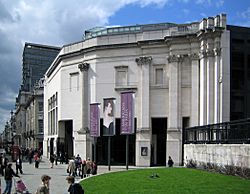
The Sainsbury Wing, seen from Trafalgar Square.
|
|
| Built | 1988–1991 |
| Architect | Robert Venturi, Denise Scott Brown and Associates |
| Architectural style(s) | Postmodernist |
|
Listed Building – Grade I
|
|
| Official name: Sainsbury Wing at the National Gallery | |
| Designated | 9 May 2018 |
| Reference no. | 1451082 |
The most important recent addition is the Sainsbury Wing. It was designed by Robert Venturi and Denise Scott Brown and opened in 1991. This wing holds the gallery's collection of Renaissance paintings.
The Sainsbury Wing has simpler, more private galleries. These rooms are designed to help visitors focus on the smaller, older paintings. The design was inspired by other famous buildings, like the Dulwich Picture Gallery. The galleries are arranged so you can see a long line of rooms, creating a clear path through the art.
After Trafalgar Square became a pedestrian-only area, the gallery started a plan to turn old office spaces into new public areas. The first part of this plan, the East Wing Project, opened in 2004. It created a new entrance from Trafalgar Square, named after Sir Paul Getty. The main entrance was also updated in 2005.
In 2024, during work for the Sainsbury Wing extension, archaeologists found evidence of an Anglo-Saxon settlement. This showed that the ancient town of Lundenwic stretched further west than people thought.
Incidents at the Gallery
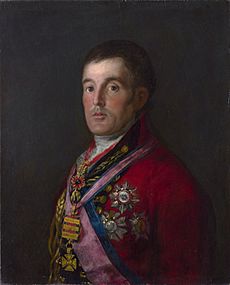
The National Gallery has seen a few interesting incidents over the years. On March 10, 1914, Mary Richardson, a supporter of women's voting rights, damaged Velázquez's Rokeby Venus. She did this to protest the arrest of a leader for women's rights.
In August 1961, Kempton Bunton stole Goya's Portrait of the Duke of Wellington. This is the only time a painting has been successfully stolen from the gallery. Four years later, Bunton returned the painting. He was found not guilty of stealing the painting itself, but guilty of stealing its frame.
In July 1987, a man shot Leonardo da Vinci's famous drawing The Virgin and Child with Saint Anne and Saint John the Baptist with a shotgun. Luckily, the pellets didn't go through the drawing, but it needed a lot of repair work. It was back on display the next year.
More recently, on October 14, 2022, Vincent van Gogh's Sunflowers was attacked by environmental activists. They threw tomato soup at it. The painting was protected by plexiglass and was not harmed, but the frame had some minor damage. On November 6, 2023, the Rokeby Venus was attacked again by activists who broke its protective glass.
Directors of the National Gallery
| Name | Time in Role |
|---|---|
| Sir Charles Lock Eastlake | 1855–1865 |
| Sir William Boxall | 1866–1874 |
| Sir Frederic William Burton | 1874–1894 |
| Sir Edward Poynter | 1894–1904 |
| Sir Charles Holroyd | 1906–1916 |
| Sir Charles Holmes | 1916–1928 |
| Sir Augustus Daniel | 1929–1933 |
| Sir Kenneth Clark | 1934–1945 |
| Sir Philip Hendy | 1946–1967 |
| Sir Martin Davies | 1968–1973 |
| Sir Michael Levey | 1973–1986 |
| Neil MacGregor OM | 1987–2002 |
| Sir Charles Saumarez Smith | 2002–2007 |
| Sir Nicholas Penny | 2008–2015 |
| Sir Gabriele Finaldi | 2015–present |
Amazing Artworks to See
The National Gallery has an incredible collection of paintings. Here are just a few highlights you can find there:
- Jan van Eyck: Arnolfini Portrait
- Paolo Uccello: The Battle of San Romano
- Piero della Francesca: The Baptism of Christ
- Giovanni Bellini: Portrait of Doge Leonardo Loredan
- Sandro Botticelli: Venus and Mars
- Leonardo da Vinci: Virgin of the Rocks
- Raphael: The Madonna of the Pinks
- Titian: Bacchus and Ariadne, Diana and Actaeon, Diana and Callisto
- Hans Holbein the Younger: The Ambassadors
- Caravaggio: Supper at Emmaus
- Peter Paul Rubens: The Judgement of Paris
- Diego Velázquez: Rokeby Venus
- Anthony van Dyck: Equestrian Portrait of Charles I
- Rembrandt: Self-Portrait at the Age of 34
- Johannes Vermeer: Lady Standing at a Virginal
- William Hogarth: Marriage A-la-Mode
- George Stubbs: Whistlejacket
- Thomas Gainsborough: Mr and Mrs Andrews
- Francisco Goya: Portrait of the Duke of Wellington
- J. M. W. Turner: The Fighting Temeraire, Rain, Steam and Speed – The Great Western Railway
- John Constable: The Hay Wain
- Claude Monet: La Gare Saint-Lazare
- Pierre-Auguste Renoir: The Umbrellas
- Vincent van Gogh: Sunflowers
- Georges Seurat: Bathers at Asnières
-
Titian Bacchus and Ariadne.jpg
Titian
Bacchus and Ariadne -
Hans Holbein the Younger
The Ambassadors -
John Constable
The Hay Wain -
J. M. W. Turner
The Fighting Temeraire -
Vincent van Gogh
Sunflowers
Artists Working at the Gallery
Since 1977, the National Gallery has invited living artists to create new works inspired by its collection. This started with a series called The Artist's Eye. Famous artists like Lucian Freud and David Hockney took part.
From 1980 to 1989, artists could live and work at the gallery for a year as "Artists-in-Residence." This program was later replaced by the "Associate Artist Scheme," which lasted until 2016. In 2020, a new "Artist in Residence" program began. These programs allow modern artists to connect with and respond to the old masterpieces.
- Artists-in-Residence (1980–1989)
- Maggi Hambling (1980–1981)
- Jock McFadyen (1981–1982)
- Michael Porter (1982–1983)
- Kevin O'Brien (1983–1984)
- Hughie O'Donoghue (1984–1985)
- June Redfern (1985–1986)
- Vivien Blackett (1986–1987)
- Philip Mead (1987–1988)
- Madeleine Strindberg (1988–1989)
- Associate Artists (1989–2016)
- Paula Rego (1989–1990)
- Ken Kiff (1991–1993)
- Peter Blake (1994–1996)
- Ana Maria Pacheco (1997–1999)
- Ron Mueck (2000–2002)
- John Virtue (2003–2005)
- Alison Watt (2006–2008)
- Michael Landy (2009–2013)
- George Shaw (2014–2016)
- Contemporary Fellowship Artist (2020–2022)
- Nalini Malani (2020–2022)
- Artists in Residence (2020–present)
- Rosalind Nashashibi (2020)
- Ali Cherri (2022)
- Céline Condorelli (2023)
- Katrina Palmer (2024)
- Ming Wong (2025)
Getting There: Transport Connections
| Service | Station/stop | Lines/routes served | How Far from the Gallery |
|---|---|---|---|
| London Buses |
Trafalgar Square / Charing Cross Station |
24, 29, 176 | |
| Trafalgar Square |
6, 9, 13, 15,139 | ||
| Trafalgar Square / Charing Cross Station |
3, 12, 88, 159, 453 | ||
| Trafalgar Square |
3, 6, 12, 13, 15, 23, 88, 139, 159, 453 | ||
| London Underground |
Leicester Square | About a 5-minute walk | |
| Charing Cross | |||
| Embankment | About a 6-minute walk | ||
| National Rail |
Charing Cross |
About a 4-minute walk |
See also
 In Spanish: National Gallery para niños
In Spanish: National Gallery para niños
- List of most visited museums in the United Kingdom
- List of most visited art museums
- List of largest art museums
- Micro gallery, an interactive computer system installed in 1991


